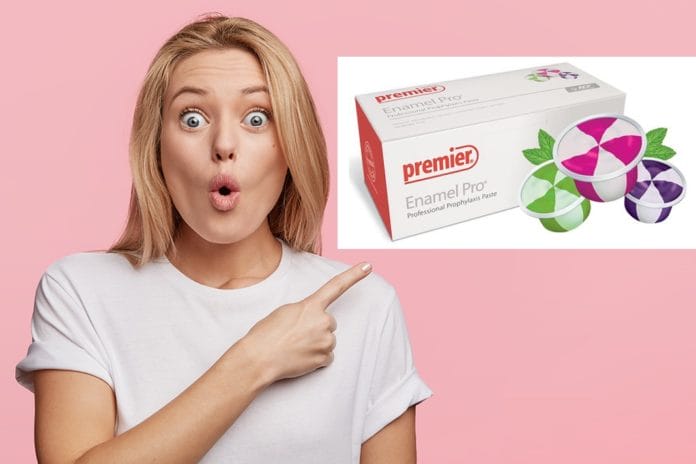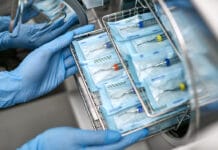Test Your Selective Polishing Protocol Knowledge
Disclosure: This quiz is sponsored content from Premier Dental as part of our sponsored partner program.
Test your selective polishing knowledge with this quick quiz and then enter to win 3 boxes of Enamel Pro® Prophy Paste courtesy of Premier Dental! (This giveaway ended on February 29, 2020)
The only prophy paste with ACP technology for 31% more fluoride uptake1
Enamel Pro® is different. Premier’s innovative remineralization prophy paste is uniquely formulated to deliver ACP (amorphous calcium phosphate). Why does this matter? Because increased fluoride uptake is critical to strengthening tooth enamel and reversing the demineralization process. Plus, Enamel Pro® prophy paste provides an intense polish and shine. Your patients will love their lustrous, whiter, brighter teeth.2,3 And the colorful swirl cups and great tasting flavors will keep them smiling. Every time.
1. Final Report: Enamel Fluoride Uptake Study #05-106 , Modified FDA Method #40, Dental Products Testing, Indiana University Emerging Technologies Center, December 2005. 2. Winston, A.E., Charig, A., Patel, V., McHale, W.A., and Malerman, R. “Effect of Prophy Pates on Surface of Tooth Enamel”, Journal of Dental Research, Vol. 84, Special Issue A. IADR Abstracts, 2005. 3. Tung, M.S., O’Farrell, T.J., Liu, D.W., Paffenbarger Research Center. ADAHF, NIST. Gaithersburg, MD. “ Dental Applications of Amorphous Calcium Phosphates” Journal of Clinical Dentistry, Vol. 10, Issue1, 1999.
Now let's test your selective polishing protocol knowledge!
1. A single polishing agent can be used for all surfaces, including enamel, root surfaces, and restorations?
Polishing agents should be selected based on the hardness of the tooth structure or restoration. The hardness of the polishing agent should be less than that of the surface being polished. Unfortunately, many of the abrasives used in prophy pastes are up to 10 times harder than the surface they are being used to polish.
Sawai MA, Bhardwaj A, Jafri Z, Sultan N, Daing A. Tooth polishing: The current status. J Indian Soc Periodontol. 2015;19(4):375–380. doi:10.4103/0972-124X.154170 Retrieved from https://www.ncbi.nlm.nih.gov/pmc/articles/PMC4555792/
2. Which of the following can contribute to tooth and restoration damage during polishing?
The greater the number of abrasive particles, the greater the abrasion. The longer the contact time of the rubber cup, the greater the rate of abrasion. The faster the rate of the rotating rubber cup, the higher the abrasion rate. The greater the force applied to the rubber cup, the greater the rate of abrasion.
Michelle Leonardi Darby, Margaret M. Walsh. Management of Extrinsic and Intrinsic Stains. Dental Hygiene: Theory and Practice Retrieved from https://books.google.com/books?id=K_VRzLaZYsoC&pg=PA515&lpg=PA515&dq=biofilm+accumulation+from+coarse+prophy+paste
3. In the past coronal polishing has been strictly cosmetic; removing stain was the goal. Now there are therapeutic prophy pastes that also strengthen teeth. What are some of the therapeutic agents available in prophy paste?
Rubber cup polishing can remove the outer fluoride-rich layer of enamel. The application of fluoride-containing prophy paste replaces some of the fluoride lost during polishing.1
Amorphous calcium phosphate (ACP) stimulates remineralization of enamel. It reacts with saliva to fill the defects caused by polishing.2 The combination of fluoride and ACP increases fluoride uptake and is especially beneficial for patients with severe demineralization.1,3
Enamel Pro Prophy Paste by Premier Dental is the only prophy paste formulated to deliver ACP and fluoride for optimal remineralization. Because ACP fills defects the teeth look and feel smoother, brighter, and more lustrous, with less risk of biofilm accumulation due to reduction of surfaced defects.
1. Michelle Leonardi Darby, Margaret M. Walsh. Management of Extrinsic and Intrinsic Stains. Dental Hygiene: Theory and Practice Retrieved from https://books.google.com/books?id=K_VRzLaZYsoC&pg=PA515&lpg=PA515&dq=biofilm+accumulation+from+coarse+prophy+paste
2. American Dental Association Product Guide. Retrieved from https://www.ada.org/en/publications/ada-dental-product-guide/product-category/product-profile?productid=654&catid=138
3. Iafisco, M., Degli Esposti, L., Ramírez-Rodríguez, G.B. et al. Fluoride-doped amorphous calcium phosphate nanoparticles as a promising biomimetic material for dental remineralization. Sci Rep 8, 17016 (2018) doi:10.1038/s41598-018-35258-x. Retrieved from https://www.nature.com/articles/s41598-018-35258-x#
4. Using coarse paste may roughen enamel surface increasing biofilm accumulation; if necessary, for stain removal, coarse paste should be followed with less abrasive pastes (medium then fine) to smooth surface roughness. The rubber cup must be changed with each smaller grit.
Prophy paste can cause damage to the enamel while removing extrinsic stain. Excessive abrasions and scratching of the tooth surface can cause a less polished appearance and increase the rate of stain and biofilm accumulation. The process of polishing should start with coarser grit and progress to finer grit. As the grit decreases through the process scratches and abrasions become smaller making a smooth appearance with much shallower abrasions reducing the risk of biofilm accumulation. Prophy cups should be changed with each grit change because particle size is different. Some of the larger particles will remain on the prophy cup from the previous grit paste. Not changing the prophy cup defeats the purpose of reducing grit.1,2
1. Sawai MA, Bhardwaj A, Jafri Z, Sultan N, Daing A. Tooth polishing: The current status. J Indian Soc Periodontol. 2015;19(4):375–380. doi:10.4103/0972-124X.154170 Retrieved from https://www.ncbi.nlm.nih.gov/pmc/articles/PMC4555792/
2. Michelle Leonardi Darby, Margaret M. Walsh. Management of Extrinsic and Intrinsic Stains. Dental Hygiene: Theory and Practice Retrieved from https://books.google.com/books?id=K_VRzLaZYsoC&pg=PA515&lpg=PA515&dq=biofilm+accumulation+from+coarse+prophy+paste
5. Contraindications for use of coarse prophy paste include:
Newly erupted teeth are not fully mineralized; polishing could cause excessive damage to the tooth structure. Dentin and cementum can be abraded 25 to 35 times faster when compared to enamel. Demineralized tooth areas, such as those with dental caries, lose three times as much tooth structure as enamel during polishing. Polishing restorations can result in roughened surfaces compromising the integrity of the restoration and creating increased risk of biofilm formation. Polishing these surfaces should be avoided, or the finest prophy paste grit should be used to prevent damage of tooth surfaces and restorations.1,2
1. Sawai MA, Bhardwaj A, Jafri Z, Sultan N, Daing A. Tooth polishing: The current status. J Indian Soc Periodontol. 2015;19(4):375–380. doi:10.4103/0972-124X.154170 Retrieved from https://www.ncbi.nlm.nih.gov/pmc/articles/PMC4555792/
2. Michelle Leonardi Darby, Margaret M. Walsh. Management of Extrinsic and Intrinsic Stains. Dental Hygiene: Theory and Practice Retrieved from https://books.google.com/books?id=K_VRzLaZYsoC&pg=PA515&lpg=PA515&dq=biofilm+accumulation+from+coarse+prophy+paste
NOW: Follow Premier Dental on Facebook










